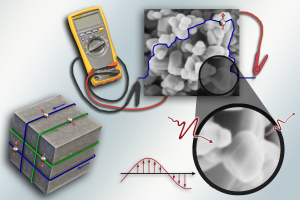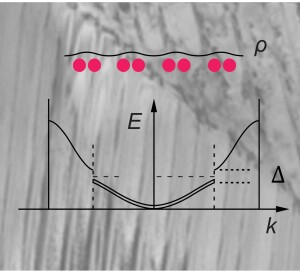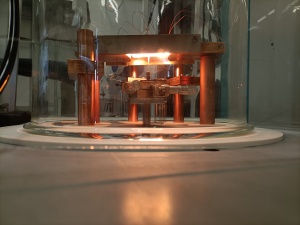Research
Quantum materials based on nanoparticles

Table-of-content Figure, DOI: 10.1002/smll.202103281
Since the discovery of non-trivial electronic band structures characterised by topological surface states in three-dimensional topological insulators, the characterisation and possible exploitation of this fascinating physics has excited the scientific community. These topological surface states exhibit electrons that are - in principle - massless and protected from backscattering. These properties suggest that there is a transport channel characterised by very high charge carrier mobility. These unique electronic properties raise visions for potential applications in quantum computing and spintronics and may provide solid-state physics' answer to the question of how nanoscale devices can be contacted efficiently. However, despite a decade of intensive research, the harnessing of these fascinating transport properties has been hampered by one major limitation: the transport properties are usually dominated by the charge carriers from the interior of the materials, of which there are orders of magnitude more compared to the charge carriers on the surface. Nanoparticles offer a solution to this problem. Nanoparticles are characterised by their large surface-to-volume ratio. A material design based on nanoparticles therefore makes it possible to investigate the transport properties of topological surface charge carriers at relatively high temperatures on macroscopic samples.
Current questions:
- How can the nanoparticles be compacted into bulk materials in such a way that the particle properties are retained while still benefiting from the high surface area? What morphology is favourable?
- How can we then characterise the surface transport of these materials? As a rule, the problem here is that the volume of the sample contains a large number of normal conducting electrons and the signals overlap. Only at very low temperatures and high magnetic fields can the signatures of the surface transport be found quite clearly.
- Which material compositions favour surface transport? What effect does the formation of alloys have?
- Can the surface transport channels be utilised for applications? Many energy applications (e.g. catalysis) could possibly benefit from the extraordinary transport properties. However, tellurides and selenides do not show particularly good stability in aqueous solution. Therefore, it is necessary to understand how these materials behave in applications and how their stability can be improved.
These questions are being investigated in the group of Dr. Sepideh Izadi.
Electronic instabilities during phase transitions

Graphical Abstract, DOI:10.1002/aenm.202300754
Martensitic phase transitions are a traditional research topic originating in metallurgy, known by the martensitic phase transition in the iron-carbon phase diagram (steel). Important functional properties such as the (magnetic) shape memory effect, caloric effects and ferroelectricity are associated with martensitic phase transitions. Moreover, such phase transitions favour the occurrence of charge density waves and seem to occur frequently in superconductors. Consequently, the electronic driving forces of these phase transitions, such as the formation of charge density waves, symmetry lowering, charge ordering, nematicity, etc., are studied in solid state physics, while many applications are optimised in the field of engineering. Surprisingly, fundamental questions about the role of electronic driving forces in application-relevant materials are rarely addressed because these topics are anchored in different disciplines.
In our group, we use transport measurements in combination with microstructure analysis to characterise the electronic contributions and the resulting microstructure during this phase transition. One model system that we are investigating in collaboration with our partner at the Ruhr University Bochum, Prof Jan Frenzel, is the shape memory alloy NiTi. The mechanism behind the transport anomalies is presumably the formation of charge density waves, which determine not only the functionality but also the microstructure in these materials. However, how the very pronounced microstructure of these samples affects the electron system is completely open.
This topic will be investigated in the future (starting from 11.2024) in the working group of Dr. Klara Lünser.
Cristal growth
 As this work is highly dependent on the availability of high quality samples, we have recently started to produce single crystals of the corresponding intermetallic compounds ourselves. This includes the design and construction of new crystal growth equipment. The group currently has a Bridgeman furnace, a self-built micro-pulling down system and standard furnaces for solid state synthesis. A crystal growing system that utilises the floating zone method is currently under construction. The crystal growth work is combined with thermodynamic and structural characterisation (DSC, SEM, ...).
As this work is highly dependent on the availability of high quality samples, we have recently started to produce single crystals of the corresponding intermetallic compounds ourselves. This includes the design and construction of new crystal growth equipment. The group currently has a Bridgeman furnace, a self-built micro-pulling down system and standard furnaces for solid state synthesis. A crystal growing system that utilises the floating zone method is currently under construction. The crystal growth work is combined with thermodynamic and structural characterisation (DSC, SEM, ...).
The crystal growth group is headed by Dr. Alexander Kunzmann.

